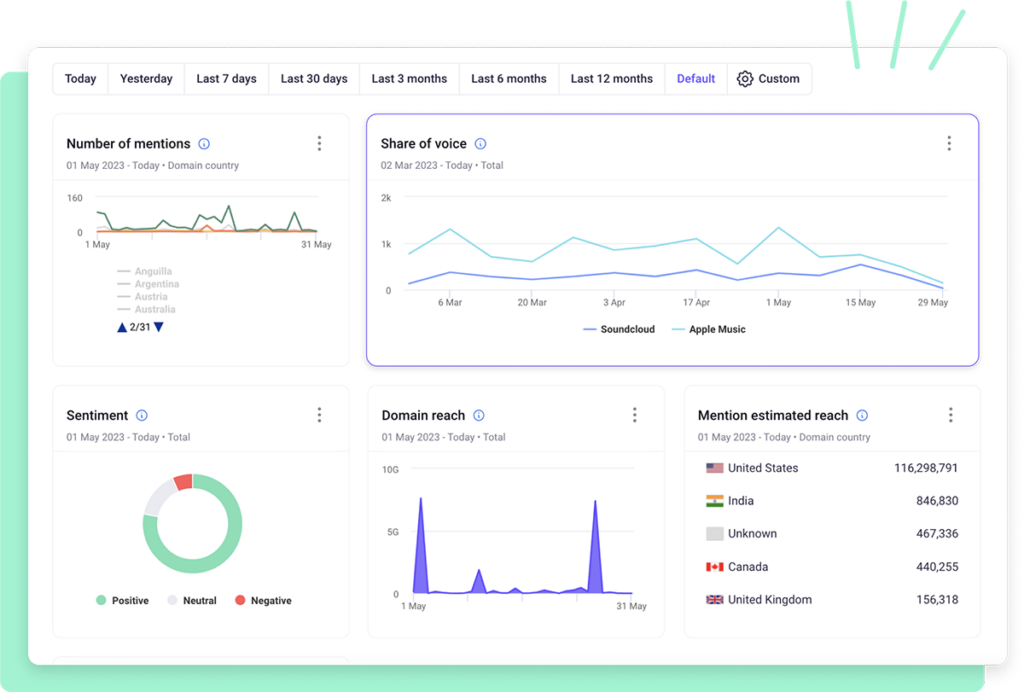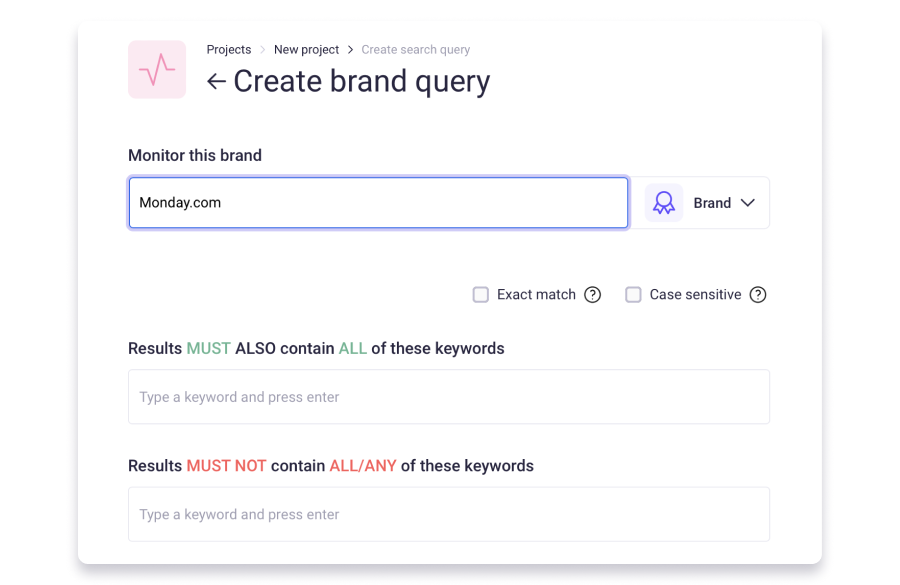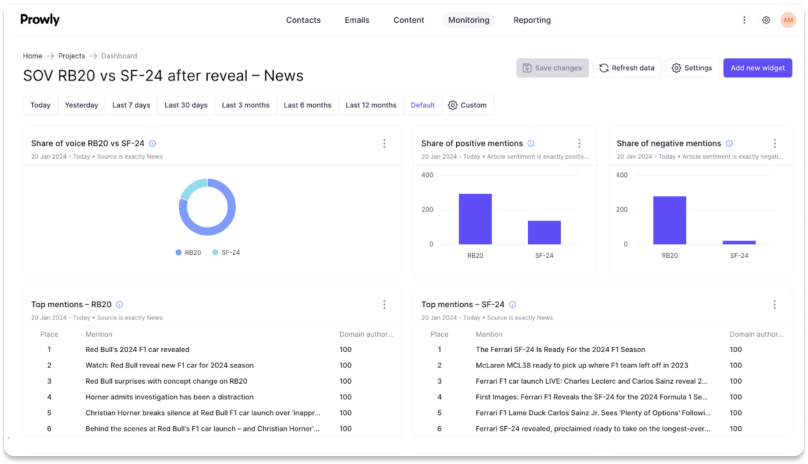Truth is, not everyone understands the importance of brand engagement. It's not just all about cute social media posts, colorful gadgets at conferences, or trends.
When done correctly, a long-term brand strategy can make or break a company and its standing on the market. In this article, we'll delve into how to prove that your strategy is working with concrete metrics that can easily show off your success.
Looking for a comprehensive all-in-one PR tool?
Try Prowly completely free for 7 days in a platform with everything you need for PR.
- All-in-one software: Get everything you need in one tool for PR, incl. media database, outreach, reporting, and more
- Transparent pricing: Plans start at $258/month
- Comprehensive monitoring: Track the web and social media mentions.
What is brand engagement?
By definition, brand engagement refers to the interaction and attachment between consumers and brands.
💡 The higher brand engagement is, the more the audience is interested in the brand, has an emotional attachment to it, and this means loyalty.
Think of it this way - if you're a fan of one brand that is known for making jeans, you'll likely never look at their competitors when trying to make a purchase. Same goes for any brand, from software to retail, to food, and everything else in between.
You might like their posts on social media, visit their physical store (if possible) more frequently than others, or even leave rave reviews online.
All of these are signs that you're highly engaged with the brand. In other words, you're an active participant in what the brand does internally and externally.
Customer engagement vs. brand engagement
While these two concepts are closely related, they're not exactly the same. Customer Engagement is more about what the consumers are "doing" and Brand Engagement is more about what people are "feeling."
But let's break it down even further:
Customer Engagement revolves around direct interactions between a customer and a brand, such as making purchases, talking and engaging with that brand's customer service, and social media interactions.
👉🏼 If you're liking a brand's posts, watching their TikTok's, and saving their reels, you're an active participant in their customer engagement strategy.
🟰 This type of engagement is important in making immediate sales (for example, through a CTA on their Instagram story) and improving customer satisfaction by gathering insights about their audience.
Brand Engagement is a broader concept and focuses on the emotional and psychological relationship that consumers have with that brand.
👉🏼 It goes way beyond simple interactions, covering perceptions, values, and the emotional connections customers associate with a brand.
🟰 Here, the ultimate aim is to build long-term loyalty and relationships that influence how the customers feel about the brand and, subsequently, how they integrate it into their lives.
Internal brand engagement vs. external brand engagement
Ready for more definitions?
The distinction between these two is important to know, especially since both are critical components of a brand's overall engagement strategy. They're both essential for success, but target different audiences.
Internal Engagement refers to the level of engagement a brand achieves with its employees. It includes how motivated employees are, their participation in company activities, and how well they connect to the brand's values and goals.
👉🏼 If internal brand engagement is high, its employees become more committed, more productive, and have higher motivation to take the company further.
It goes without say that this type of engagement affects their quality of service, innovation, and overall customer experience. Happy employees = better products.
External Engagement focuses on the brand's interactions with their audience and the public. This includes things like their marketing efforts, customer service, and social media interactions.
👉🏼 External brand engagement aims to build strong connections with others, which further translates to better customer loyalty and brand recognition.
It also has a lot to do with how the company communicates its message and values to the world, creating a positive brand reputation.
But! Before you can effectively measure engagement, it’s essential to understand what drives visibility in the first place.
Try Prowly's media monitoring free for 7 days
Start tracking your brand and keywords for free (no credit card required) in Prowly.
- Comprehensive monitoring: Track the web and social media mentions.
- Transparent pricing: Plans start at $258/month
- All-in-one platform: Get everything you need in one tool for PR, incl. media database, outreach, reporting, and more
Why should you measure brand engagement?
Brand engagement is more than comments on your recent outlet coverage.
Since the line between public relations and marketing is as blurred as it can be, some of these metrics might be useful for you to prove your strategy is working.
Measuring brand engagement is important, because it highly influences things like word-of-mouth marketing, enhancing brand awareness, and trust among your audience.
👉🏼 When this metric scores high, customers are more likely to be talking about you positively on different social channels and forums.
Imagine you're having trouble showing your campaigns are effective in a clear and easy way. With brand measurement metrics, such as Share of Voice, you can show your clients or stakeholders that you, indeed, have a competitive edge. More on that later in this article!

"Brand marketing is a marathon, not a sprint. The results won’t come overnight, but play the long game, and your brand will strengthen your attribution channels and create lasting impact. Consistency is your secret weapon—whether it’s your messaging, tone, visuals, or values. Not everyone will vibe with your brand, and that’s okay. You’re not here to please everyone; you’re here to build genuine connections with those who truly resonate with your brand and values."
Viktoriia Stepanova, Brand Team Lead @Prowly
👉 If you’re looking to lay the groundwork before diving into engagement metrics, check out our guide on brand visibility—what it is and how to improve it.
Where do consumers engage with brands?
There's so many places people can directly or indirectly engage with brands. Here are some examples:
- Social media channels (e.g. TikTok, Instagram)
- Discussion forums (think Reddit)
- Brand websites
- Email campaigns
- In-store experiences
- In-person, phone, or chat customer service interactions
- Online reviews and ratings
- Mobile apps
- Publicly available events
- Reward programs
💡 Tip: Read this full guide on social media reputation to get a complete picture of your marketing and PR strategy.
How to measure brand engagement?
#1 Measure Share of Voice
The most effective way to set brand engagement KPIs is to evaluate them through a metric called Share of Voice.
With this, you can track your key competitors and see how you stack up against them.
There's plenty of ways in which you can do this, for example, by comparing your brand to larger brands you aspire to be like in a year, two, or five, and at the same time, set up a comparison by tracking brands with the same market share as you.
Then, you'll know which media categories and more niche outlets to explore, and even find opportunities to check out which journalists you might have missed in your search (and start pitching to them now).
How to track brand Share of Voice?
You can start by setting up a simple query for your competitors and go even further to get more quality insights about your brand's presence per channel, niche topic, etc.
When creating your dashboard, choose from these filters to get a detailed analysis:
- Article category: to explore where your media visibility is the highest and where there's an opportunity for improvement
- Sentiment: to see if it's similar across all channels and to keep an eye on your brand's reputation
- Backlinks: to check if there's any potential to improve SEO to rank your page higher
- Language: essential for international brand analysis
- Source: to distinguish SoV between different channels, outlets, blogs, and discussion forums (like Reddit or Quora)
Additionally, you can gather all the data in a timeline and view changes using graphs so it's easier for people to see your progress (even if someone has no clue what SoV is or how to calculate it, everyone is happy when they see a line trending upwards).

If you want to explore more than just mentions of your brand, you can also use Prowly's Media Monitoring to track a keyword (following trends and overall media interest) or a person (maybe your CEO made an impact?) and compare their SoV as well.

"I use Prowly to track media mentions and see how our brand is being talked about. It’s super simple—I set up a project with our brand keywords, and every mention automatically flows into my reporting tool. I organize it by month, tracking key metrics like Total Estimated Views and Average domain authority, which gives me a clear picture of our brand’s monthly performance. It’s a game-changer, especially for spotting trends and seasonality in our campaigns."
Viktoriia Stepanova, Brand Team Lead @Prowly
#2 Count brand search clicks and impressions using Google Analytics
- First, connect Google Search Console with Google Analytics.
- Then, go to the "Acquisition" tab, followed by "Search Console" and select "Queries" to see what keywords led to clicks and impressions of your brand.
- Last, make sure you filter the report with your brand name or variations (misspellings and all).
#3 Evaluate social media engagement
How to measure engagement on socials? Every platform provides you with detailed analytics, especially when you specify your profile is a brand or business. You'll be able to see the number of likes, shares, comments, saves, and how your followers are growing.
You can do so with different social media management tools, or aggregate it in Google Analytics.
#4 Assess new contacts generated from brand channels
Google Analytics or a CRM is a great way to monitor email subscriptions, form submissions, and sign-ups to dig up potential leads.
You can set up individual goals or track conversions and ongoingly review the data to evaluate the effectiveness of your lead gathering strategy.
#5 Give out brand awareness surveys
Surveys are a great way to learn more about your brand and its audience (providing they're short and sweet).
Use tools like Google Forms or SurveyMonkey to get responses and distribute surveys through newsletters, emails, social media channels, or your website.
#6 Calculate growth in branded keyword searches
Use a media monitoring tool to track the number of mentions your brand is generating to analyze how your PR strategy is giving the business a positive ROI.
Brand awareness lies on top of the sales funnel and proving what you're doing is working should be at top of your list.
When doing this, don't overlook traditional media when conducting your regular research! Be sure to check mentions in print magazines, radio programs, and television.

You can combine online media monitoring with print and broadcast monitoring in Prowly to have mentions from both digital and traditional news sources at your fingertips—all in one place.
How to measure growth in branded keywords?
When using Prowly, you can create a dashboard where you can show a timeline of your mentions and correlate it with the strategies you've implemented.
👉🏼 That way, you can show the outcomes of your work and campaigns (e.g. growing positive sentiment on Instagram) and compare it against different business data.
Additionally, using alternative tools, you can compare other KPIs you've set with things like website traffic, keywords, incoming leads, webinar signups, app downloads etc.
You can even do so by using a custom widget.

💡 Bonus tip: Prowly users can automatically add such timelines and charts to PR Reports to present their accomplishments to clients and stakeholders.
#7 Analyze increases in referral traffic
Using Google Analytics, you can see where your website traffic is coming from.
Simply go to the "Acquisition" tab, then select "Referrals." There, you'll see the volume and quality of traffic over time. You can analyze it to see how your brand is engaging its audience through external channels.
#8 Evaluate email engagement
Your brand engagement strategy should also involve emails— I promise email marketing isn't dead. Your platform could be monitoring new sign-ups closely, along with their open rates, click rates, and read rates, which makes it easier to see if your content is engaging to your readers.
9 ways to increase brand engagement
We wanted to keep it short and sweet.
Here are some ways in which you can increase your brand's engagement and get your company recognized on the market:
- Host contests and giveaways: these encourage participation, and often boost the algorithm on some platforms as well as people comment and share the content with others.
- Encourage user-generated content: create fun and unique hashtags, use their photos on your own socials (remember to always ask for permission), share your positive reviews and success stories across your platforms.
- Start discussions: get creative and engage with your audience through questions, quizzes, or anything that can spark a conversation.
- Get influencers and creators involved: partner with people's favorite creators to reach new audiences and increase overall engagement.
- Offer discounts: give your most loyal consumers better promotions through limited-time campaigns.
- Implement a loyalty program: get people going with rewards and points, discounts, or exclusive perks.
- Make word-of-mouth fun: create referral programs that reward customers for bringing in new business, or think of opportunities where your audience might want to share something newsworthy with others.
- Engage with user feedback: foster deeper connections by acting on customer reviews to show you value their opinions.
- Show off social proof: use testimonials from clients, draft case studies, and share reviews to build trust and encourage engagement.
Brand engagement case study: Spotify Wrapped
Wondering how measuring brand engagement looks in real life? Let's take a look at one of the most popular cases—Spotify Wrapped.
They do something that's pretty genius. They take all the data from the songs you've listened to and wrap it all up in a "Spotify Wrapped" playlist. It's like a personalized report on what you've been jamming to all year long.

The campaign is all about turning users own data into something they can share with others and laugh about. And honestly, it works like a charm. I can't recall one person that hasn't heard about it.
How do they measure engagement?
👉🏼 They look at how many people share their news with others on social media, how much people are engaging with the content, and how the brand's visibility increases during that time of the year.
👉🏼 Brand tracking metrics such as the number of shares, social media mentions, and overall sentiment analysis are their key indicators.
Every year, Spotify Wrapped practically takes over everyone's feeds, from your best friend's story to your favorite celebrity posts. They all want to share their top tracks and what they've been listening to.
Spotify has turned this campaign into a cultural moment.
By using data-driven storytelling techniques, they've not only strengthened their brand loyalty, but also increased organic promotion without the need to spend money on ads.
How's that for a case study on brand engagement?
To get a bit of inspiration, you can read more about brands and their stories, in addition to the popular case studies you can easily find by doing a quick Google search.
12 brand engagement metrics (a simple checklist)
- Share of Voice (monthly, quarterly, yearly)
- Brand search clicks and impressions from Google Analytics
- Social media engagement
- Number of followers
- Post or advert engagements
- Comments on posts
- Brand mentions
- New contacts generated from brand channels
- Brand awareness surveys
- Email subscriptions and read percentages
- Growth in branded keyword searches
- Increase in referral traffic
If you're looking for a complete list of PR metrics, make sure to check out this article covering what to measure and why (with examples).
The importance of brand engagement
Evaluating brand marketing and its engagement got a tad bit easier once we implemented social media into our strategies. Because, let's face it, there are nearly no brands in the world that don't need some kind of platform to gather their community.
By measuring and evaluating brand measurement metrics, we can make it easier to prove that our strategy is bringing in the kind of ROI clients and stakeholders are hoping to achieve.
Start gathering data about your brand, including mentions, branded keyword engagement, social media metrics and more, using Prowly's Media Monitoring.

